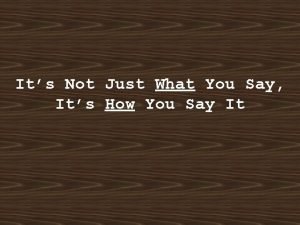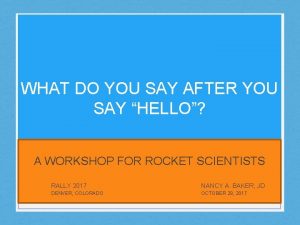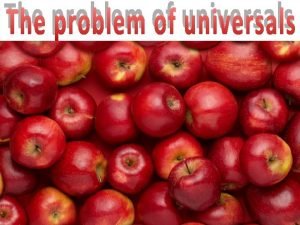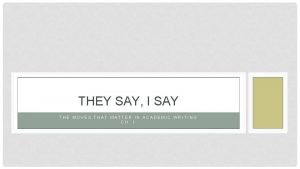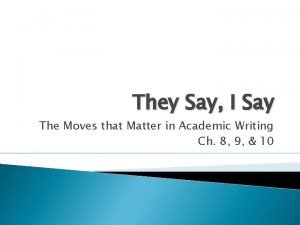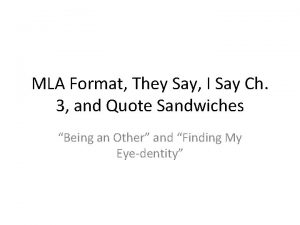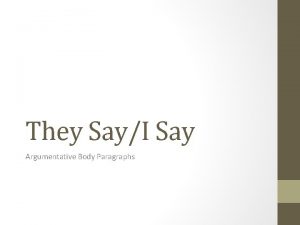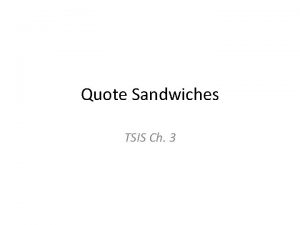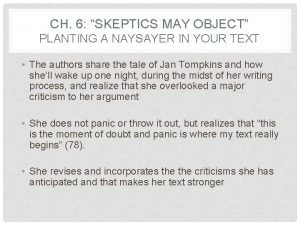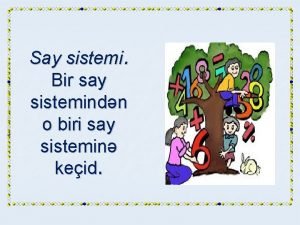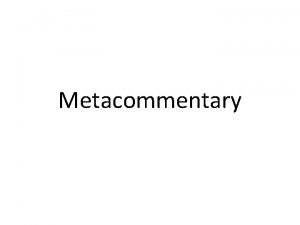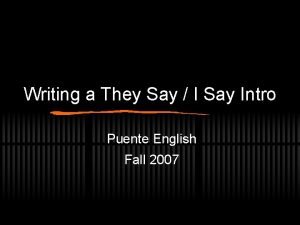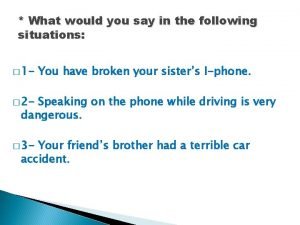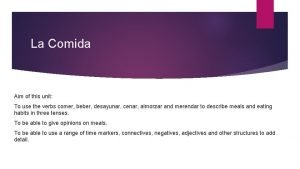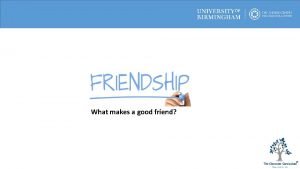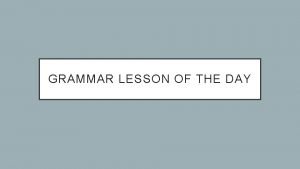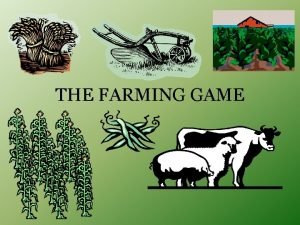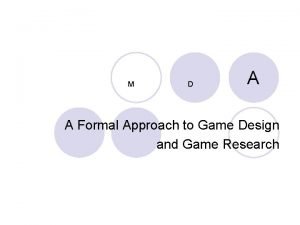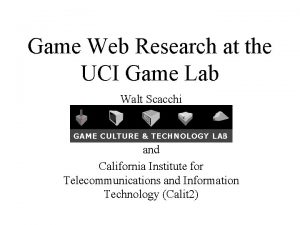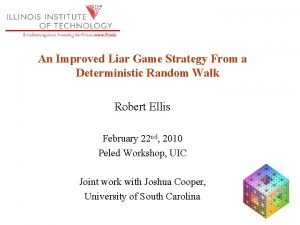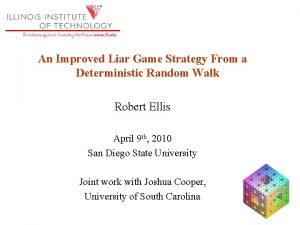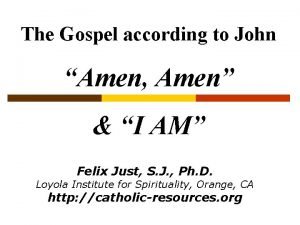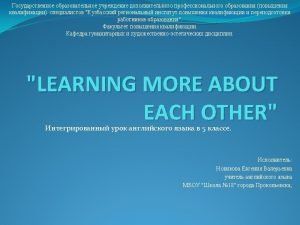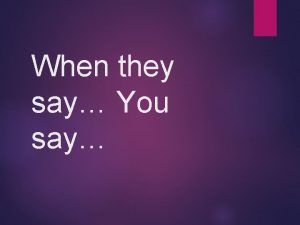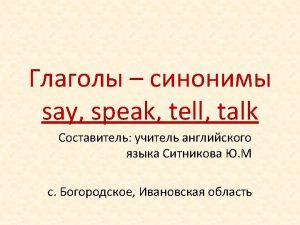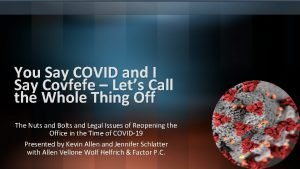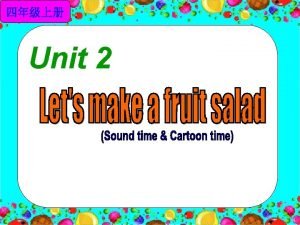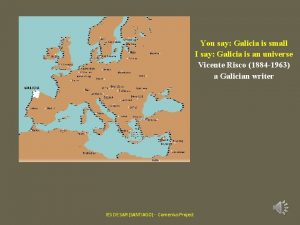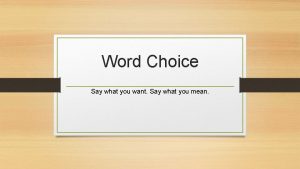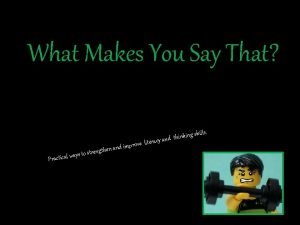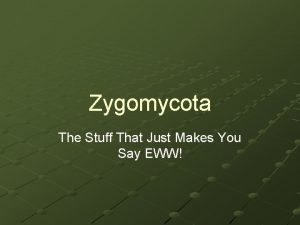Whats a game What makes you say that





















































- Slides: 53


• What’s a game? – What makes you say that something is a game? – What’s in common among all games? – There must be something in common right?


• What’s a triangle?

What’s red?

Particulars • Individual things, objects, people, animals • Non-repeatable (not multi-exemplifiable) • Cannot be in more than one place at a time

Universals • All games are games because they participate in a universal concept: “Game-ness” • All cats participate in a form: “Cat-ness” • All red things are red because they participate in “red-ness” • So, Game, Cat, Red (and more) are examples of universals.

Individuals • Individuals are material • Universals aren’t • Universals must be wholly present in each place or object at the same time. – Red apple and red ruby are both red at the same time. Red is wholly present in both • If I eat the apple, red does not diminish or disappear – Nor does redness increase as new apples grow!

Entities Particulars (Things, objects) Universals (attributes) Properties Kinds Color, shape, hardness, smoothness Biological species: Dogs, cats, human, Rose, life forms Genera: Animal, plant Element Relations Next to, a mile from, between, equidistant…

The immateriality of universals generates problems: • Causation: one thing or even affects another through contact by interacting with one another. • This is so if the cause is material. • How do universals—which are immaterial— interact with particulars? • And how do we know these immaterial universals? – They interact with our brains?

Are universals that strange? • Proving universals is like proving the existence of quarks, Higgs boson, atoms, and so on. • Those entities are no less controversial than universals. • Scientists believe that theories explain observable phenomena. • Black holes, dark matter, evolution: we don’t see them, but detect their effects.

• Similarly, universals explain aspects of the world. • What is a name? it is something that picks out an object or person: “Joe” means (names) a person. • The name “Sglork” means nothing because it does not refer to anything. – It does not pick out anything – There is no referent

Meaning and Knowledge • Universal explain meaning: What about red, wise, 3, large, cat • What gives them meaning? – Universals give meaning – If “red” is a description of red things but red is a subjective feature of the world, then “The apple is red” would be false. • Universals explain knowledge: • Knowledge vs. opinion? • Laws of nature

• Many believe that it is the world that makes names and predicates true. • However, consider morality.

THE PROBLEM OF UNIVERSALS Realism Nominalism Fictionalism Conceptualism

Realism • Realism says, Yes, things and events in the world share commonalities: red, just, circular, etc. • Extreme realism: Plato, the forms – 3 components: 1. apple, 2. red in the apple, 3. Form of red. • Forms are immaterial, timeless, spaceless. • An apple participates in the Form • Is the form of red itself red? Triangle a triangle itself?

• Strong realism: Aristotle. Individuals have qualities of their own, circular, triangular, etc. they are in the objects. • On this view the universal is present in the object and other similar objects. • The universal is natural: – This apple is red, that guy is tall – Tallness and redness are the qualities in them – Universals exist in space and time

• Realists typically claim that universals are monadic: they are exemplified one by particulars. • Also relations: universals exemplifies by various relations among particulars: “being a mile apart” exemplified by 2 objects. • “Being next to” again, exemplified by 2 objects. • Being next to and a mile apart are symmetrical. • Some are a-symmetrical: “Being the father of…”

• Relations are polyadic (many-place) • Properties like colors, virtues, shapes are monadic. • many realists call properties monadic, others (influenced by Aristotle) further divide monadic universals into properties and kinds. • Kinds are species; properties are “possessed” by things. • I am a Homo sapiens, but do not possess Homo sapiens.

• A triangle has 3 sides and trilaterality is possessed by triangles. • A triangle is geometrical figure—that’s its species, which is not possessed by the triangle. • An object exemplifies kind by belonging to it. • An object exemplifies properties by having certain properties.

• 2 things can agree in belonging to a single kind, agree to in possessing that property. • Realists argue that attribute agreement comes in degree: – A dog and a cat agree in kind, both are mammals. But two dogs have stronger agreement in kind.

Objections • The strangeness of universals: Too weird! – Seems contrived – Remember the argument from queerness? • Ockham’s razor – Entities should not be multiplied without necessity. • Third man – Aristotle: If a man is a man because he is an example of the Form of man, then a third form (third man) is required to explain how a man and the Form of man are both man, and so on, ad infinitum.

Linguistic objection • The sentence “The rat is grey”. Is it true? Yes if there is a grey rat and the rat is an example of the Form grey. • So it is true because of another statement: “The rat exemplifies greyness. ” But what makes this sentence true? • Another sentence: “The rat is an example of the exemplification of greyness. ” • And we’re off on an infinite regress!

• Consider the property “Does not exemplify itself” What satisfies it? Those things that do not exemplify themselves. – The concept of being the Pope is not the Pope. – The concept ‘Road kill’ is not itself road kill. – On the other hand the property of being incorporeal is incorporeal. – The property of being self-identical is self-identical.

• But what about the property “Does not exemplify itself”? (Not being an example of itself) call it ‘non-self-exemplifying’ • Does it exemplify itself or not? • ‘non-self-exemplifying’ = Yes, it is an example of itself. But then if the property “Not being an example of itself” is an example of itself, then it (“Not being an example of itself”) is not an example of itself because it is the property of a things that dos not exemplify itself.

• Now let’s say that it is not an example of itself: ‘non-self-exemplifying’ = No, it is not an example of itself. • But then if the property “Not being an example of itself” is not an example of itself, then it (the property “Not being an example of itself”) is an example of itself because it is the property of a thing that dos not exemplify itself. ? !? !? !

Restrictions • The preceding paradoxes seem to show that realism is false. • Many realists concede the regresses and paradoxes but claim they do not undermine realism. • They claim we have to restrict realism. – The rat is grey because it partakes greyness—full stop! – Not all properties exist: “Non-self-exemplifying” is not a universal (what is it then? !)

Regress ad infinitum • Other realists are not worried about regresses. – If the mouse is grey, it is because of the universal ‘greyness’. – Why is greyness and the mouse the same? Because of some other universal? – At any rate the realist claims to have explained why the rat is grey. • PROBLEM: if you accept the regress, there are too many universals!

More restrictions • Consider the term ‘bachelor’. • According to realism there is a Form ‘Bachelor’ But which universal is that? • Presumably, the universal of being a bachelor. • But that is a property had by a male, unmarried, human. • Too many properties (again)!

• We need the property ‘Human’ for a human, the property ‘Unmarried’ for unmarried, and the property ‘Man’ for a man. • Why do we need ‘Bachelor’? • We can explain being a bachelor with the other properties: – An unmarried man. • In fact, why do we need the negative property ‘Unmarried’ • Why not just say that a bachelor is one who lacks the property of being married?

Defined vs. Undefined universals • Defined universals are those directly explained by their correspondence to objects: – Triangularity is the property of having three angles. • Undefined are those like bachelor. • PROBLEM: who decides how to define a universal?

• Furthermore, realists are divided on the issue of whether universals exist irrespective of their being instantiated. – Suppose cell-phones had not been invented. – Would the universal ‘Cell-phone’ exist? • Some realists argue that only those universals that are exemplified exist.

Anti-realism • 2 kinds of anti-realism: – 1. Nominalism: No universals exist. Individuals explain everything. – 2. conceptualism: individuals alone do not explain everything. You need concepts of ideas.

Predicate nominalism • Predicate nominalism: Tom is red. “Is red” is true of Tom and can be true of Bob, Jeff, etc. • Only individuals and words exist. – Objection: What exactly makes it true that Tom, Bob, Jeff are red? – What’s in common cannot be mere words! – The predicate “is red” applies only to certain individuals.

Austere Nominalism • Austere nominalism says that what explains ‘The rat is grey’ or ‘Socrates is virtuous’ is that the rat is grey and Socrates is virtuous—duh! • Too simple? Well realism is simple too: – What explains ‘The rat is grey’” – The rat’s participation in grey!

Truth? • Recall that realism explain why sentences are true: – Courage is a virtue – Triangularity is a shape – Tom prefers red to blue – Red is a color • Because they pick out a referent universal that exists. Otherwise the sentences are false.

Sentences in Disguise • Austere nominalism explains truth of a statement by analyzing the sentence: – Those sentences are disguised ways to refer to particulars: • Socrates exemplifies courage = Socrates is courageous • Plato exemplifies wisdom = Plato is wise • In other words, statements are true because they refer to particular instances of general terms like ‘courage’ and ‘wise. ’

• Austere nominalism claims it’s possible to translate any sentence that involves an abstract singular term, into a sentence in which that term does not appear but the corresponding general term does: Courage is a virtue = Courageous persons are morally virtuous Triangularity is a shape = Triangular objects are shaped objects Tom prefers red to blue = Tom prefers red to blue objects Red is a color = Red objects are colored objects

• However those statements do not seem to be the same as their proposed translations: • ‘Courage is a virtue’ is true, alright. But its translation ‘Courageous persons are morally virtuous’ can be false. There are many courageous people who are not virtuous! • So, the original sentence can be true while the translation false!

Problem • Translate this! ‘That tomato and that fire engine have the same color’ ‘He has the same character trait as his cousin’ They seem to commit us to the existence of universals

• Perhaps you can find a clever way to get rid of the reference to universals. – ‘That tomato and that fire engine agree colorwise’ • (Assuming we have an account for saying that two things agree in color, which assumes a universality) • But then translate these: – Some species are cross fertile – That shape has been exemplified many times

Resemblance nominalism • Resemblance nominalism: An individual redness is explained by a thing that belongs to the set of red things. • Membership in a particular set defines what is red, pizza, man—defines what it means to have a certain property. – Objection: Everything that has a heart has a kidney. This is one set. – Consequently, belonging to this set means that having a heart and having a kidney is the same property!

– Objection 2: Resemblance nominalism suggests that we form sets and put in them things that resemble each other. But what is resemblance? ! – Red in apples resembles red in traffic lights. Also a yellow apple resembles a red apple. – But then Resemblance nominalism explains resemblance of red by reference to things that are not red.

• Granted, you can make a set of things that are only red. But then how do you explain being red? • You would have to say that being red means being in the set of red things. In other words, being red is explained by being red! • Furthermore: What is resemblance? If particular, it needs explanation. If universal, well, then there at least some universal properties.

Trope Nominalism • Trope Nominalism: Individuals are bundles of tropes. • An apple is a complex of various tropes. – A red trope – A sweet trope – An apple-shape trope • Red is not a property of the red trope, but rather red itself.

• Trope Nominalism: qualitative identity is due to the fact that individuals have tropes that are qualitative identical but numerically different. • E. g. : – A red car has red trope 1. – A red apple red trope 2. – A red cherry red trope 3. – But they don’t resemble because of a universal red.

Red 1 Red 2 Red 3 They resemble each other more closely than other tropes Red 4 Tropes have only 1 property. So members that are not red would not go into a set of tropes.

Resemblance among individual tropes Red 1 resembles red 2 Red 2 resembles red 3 Red 3 resembles red 1 • So resemblance between 3 apples is just like resemblance among tropes

Red car Red apple They resemble each other because they have tropes that resemble each other. Red cherry But why do these tropes resemble each other? If not due to a universal, why? Because they just do!

Conceptualism • Conceptualism: Generality is a feature of our minds—our concepts. The concept of redness applies to both

• For conceptualism, red or redness is general not because it denotes a real entity, but because many particulars conform to the concept ‘red’ • Problem: how do we apply the concept without a general guide? • Why could name things arbitrarily and call a green apple red. • It seems that there is something in common among red things that is mind-independent.

Fictionalism • One of the most recent claim is fictionalism. • The claim is to treat statements that involve abstract entities in the same way we treat fictional discourse: –Aeneas sailed from Troy to Italy –Achilles slew Hector • These are false statements!

• These statements are false in real life, but make sense in a fictional context. • ‘Two plus two equals four’ is literally false if we are speaking within the story of mathematicians. • Presumably according to fictionalism ‘Courage is a virtue’ and ‘Red is a color’ are literally false but true when considered within the story of… • Yes, within what story?
 It's not what you say it's how you say it
It's not what you say it's how you say it What do you say after you say hello
What do you say after you say hello What makes you say that?
What makes you say that? Do you love rain
Do you love rain You say we pay game
You say we pay game Phân độ lown
Phân độ lown Block nhĩ thất độ 2 type 1
Block nhĩ thất độ 2 type 1 Thơ thất ngôn tứ tuyệt đường luật
Thơ thất ngôn tứ tuyệt đường luật Thơ thất ngôn tứ tuyệt đường luật
Thơ thất ngôn tứ tuyệt đường luật Chiến lược kinh doanh quốc tế của walmart
Chiến lược kinh doanh quốc tế của walmart Tìm vết của đường thẳng
Tìm vết của đường thẳng Con hãy đưa tay khi thấy người vấp ngã
Con hãy đưa tay khi thấy người vấp ngã Tôn thất thuyết là ai
Tôn thất thuyết là ai Gây tê cơ vuông thắt lưng
Gây tê cơ vuông thắt lưng Sau thất bại ở hồ điển triệt
Sau thất bại ở hồ điển triệt 27 chapter outline hunger games
27 chapter outline hunger games They say i say counter argument templates
They say i say counter argument templates They say i say format
They say i say format They say i say by gerald graff and cathy birkenstein
They say i say by gerald graff and cathy birkenstein They say i say essay format
They say i say essay format Intro paragraph format
Intro paragraph format They say / i say paragraph examples
They say / i say paragraph examples Voice markers they say i say
Voice markers they say i say Peter elbow believing game summary
Peter elbow believing game summary Quotation sandwich they say i say
Quotation sandwich they say i say Planting a naysayer in your text
Planting a naysayer in your text Templates for introducing quotations
Templates for introducing quotations Ikilik say sistemindən onluq say sisteminə keçid
Ikilik say sistemindən onluq say sisteminə keçid They say i say chapter 10
They say i say chapter 10 How do you say puente in english
How do you say puente in english Fire and ice diamante poem
Fire and ice diamante poem Some say the world will end in fire some say in ice
Some say the world will end in fire some say in ice They say i say
They say i say What would you say for the following situations
What would you say for the following situations You hear: el café you say: yo ceno en el café.
You hear: el café you say: yo ceno en el café. Good morning good morning good afternoon
Good morning good morning good afternoon Do you say amen when you receive ashes
Do you say amen when you receive ashes Wheelaudit
Wheelaudit Difference between personal statement and cover letter
Difference between personal statement and cover letter A fall in a ditch makes you wiser meaning
A fall in a ditch makes you wiser meaning What makes you happy list
What makes you happy list What makes you a good friend
What makes you a good friend What makes you laugh passive voice
What makes you laugh passive voice The pirate game
The pirate game Rules for the farming game
Rules for the farming game A formal approach to game design and game research
A formal approach to game design and game research Game lab game theory
Game lab game theory Liar game game theory
Liar game game theory Liar game game theory
Liar game game theory Whats hot whats not
Whats hot whats not Amen i
Amen i Direct speech into reported speech
Direct speech into reported speech Acrostic poetry rules
Acrostic poetry rules 100 pics say what you see
100 pics say what you see
